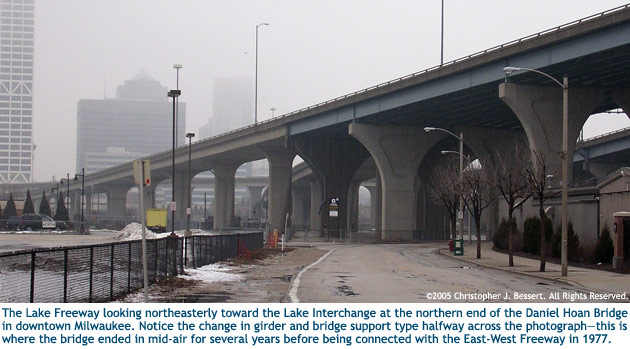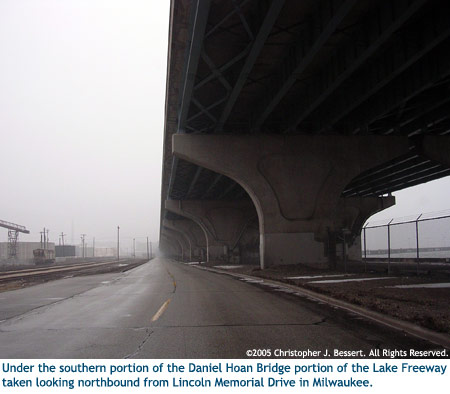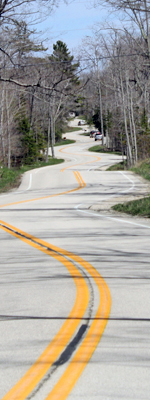Milwaukee Freeways: Lake Freeway
 The
modern-day Lake Freeway in Milwaukee actually consists of two facilities,
both occupying the route of the originally-proposed Lake Freeway from the
1950s and 1960s. The northern half of the route today consists of I-794/Lake
Freeway from the Lake Interchange—where the I-794/East-West Freeway,
the Lake Freeway and Lincoln Memorial Dr all meet near the Henry Maier Summerfest
Grounds—southerly across the Daniel
Hoan Bridge to the Carferry Dr
interchange, while the southern portion is the STH-794/Lake Parkway from
the end of I-794 at Carferry Dr southerly to its terminus at Pennsylvania
Ave just south of Layton Blvd. The original proposal for the Lake Freeway,
however, was to have continued both north and south of the present route
of the Lake Freeway-Parkway combo.
The
modern-day Lake Freeway in Milwaukee actually consists of two facilities,
both occupying the route of the originally-proposed Lake Freeway from the
1950s and 1960s. The northern half of the route today consists of I-794/Lake
Freeway from the Lake Interchange—where the I-794/East-West Freeway,
the Lake Freeway and Lincoln Memorial Dr all meet near the Henry Maier Summerfest
Grounds—southerly across the Daniel
Hoan Bridge to the Carferry Dr
interchange, while the southern portion is the STH-794/Lake Parkway from
the end of I-794 at Carferry Dr southerly to its terminus at Pennsylvania
Ave just south of Layton Blvd. The original proposal for the Lake Freeway,
however, was to have continued both north and south of the present route
of the Lake Freeway-Parkway combo.
The roots of the Lake Freeway/Parkway date back to the 1920s when the Lincoln Memorial Dr opened in 1929 from downtown northerly along the lakeshore, providing easy access from the east side into downtown. Meanwhile, southsiders in Bay View, Cudahy and South Milwaukee had to endure Kinnickinnic Ave and South 1st St to get from their communities into the downtown area. As those streets became more and more congested with automobile traffic, residents south of the harbor campaigned hard for a southern extension of the Lincoln Memorial Dr to serve their areas as well. The Depression ended those plans until the late 1930s when, once again, the City of Milwaukee began plans for such a roadway, now including a bridge or tunnel at the Milwaukee River. As the plans for this project were submitted on December 17, 1941, ten days into the U.S. involvement in World War II, the project was again shelved. After the war, the southsiders continued their push for better access along the lakefront, but by this time, the highway and bridge had become so expensive that the plans were shelved for a third time and would not see the light of day for another twenty years.
Enter the freeway era and in 1963, the Daniel Hoan (then called the Milwaukee Harbor) Bridge was officially added to the new Milwaukee freeway system and the Lake Freeway from downtown at the Park Freeway (East) southerly to Layton Ave, using the Hoan, was officially added to the planning maps in 1967. A future extension of the Lake Freeway south of Layton Ave through Racine and Kenosha Counties to the Illinois state line and a connection with a lakeshore freeway there were also proposed at the time. From the south end of the Hoan Bridge, the Lake Freeway was to have followed the Chicago & North Western (now Union Pacific) Railroad.
The first organized opposition to a Milwaukee area freeway came in September 1965 at a public hearing for the Lake Freeway through Juneau (now Veterans) Park in downtown Milwaukee. This segment of freeway would have stretched between the eastern ends of the Park Freeway (East) and the East-West Freeway and made up what became known as the "Downtown Loop Closure Freeway." Opponents of the freeway felt the six-lane freeway and its attendant ramps would block the downtown area from a prized possession: the lakefront. The battle waged on until 1971 when the opposition to the freeway through Juneau Park obtained a court injunction against the project which was upheld by the State Supreme Court two years later.
The primary reason why the "Downtown Loop Closure" was defeated was a reversionary clause from the 1936 transfer of the park from the City to Milwaukee County which stated if the land was no longer used for park purposes, it would revert to the city. By this time, many city leaders were in the anti-freeway camp, meaning any reversion back to the City would result in the freeway not being built. Thus, the Lake Freeway north of the Lake Interchange with the East-West Freeway faded into history and the fate of the stub-ended Park Freeway (East) was sealed, albeit thirty years later. Legislation in 1981 officially removed the Lake Freeway (North) from the state trunk highway system, removing it from all further consideration.
Meanwhile, south of downtown, the residents of Bay View, Cudahy and South Milwaukee finally got their new highway—the improved access they had been requesting since the 1920s. However, it was much more than they ever bargained for: a six-lane freeway. Opposition steadily grew until 1974 when the Daniel Hoan Bridge was completed and local residents successfully campaigned to keep the bridge unconnected from other area freeways and streets. There the Hoan sat, unusable, for three years and quickly became known as "The Bridge to Nowhere." The Hoan itself was almost universally supported by civic leaders, including Milwaukee Mayor Henry Maier, as the bridge would facilitate easy access to the city-owned port at its south end.

Finally in 1977, the Hoan was connected to the rest of the freeway system as part of I-794 when ramps were built at its northern end to connect with the East-West Freeway and on the south to Carferry Dr. After the Hoan opened to traffic—and with it, the first official stretch of the Lake Freeway—it dumped a great deal of traffic onto the streets of the Bay View neighborhood, angering local residents and further cementing their opposition to the planned Lake Freeway southerly extension to Layton Ave. The Lake Freeway would remain stalled at Carferry Dr for over twenty years. At the same time as the legislation which removed the Lake Freeway north of the East-West Freeway from consideration in the early 1980s, similar legislation also modified the route of the Lake Freeway south of Carferry Dr to a nearby, proposed surface arterial road.
Amid the negativity and opposition the Milwaukee area freeway system spawned, one somewhat comical moment cropped up in 1979. Until the mid-1980s, ramps at the lake Interchange from the East-West Freeway to the cancelled Lake Freeway (North) sat unfinished, ending in midair. A scene from the 1980 film "The Blues Brothers" starring John Belushi and Dan Aykroyd was filmed at that location. For those who have seen the movie, it was the scene where Jake & Elwood Blues are being chased by the "Illinois Nazis" down a freeway which appears to be under construction—the East-West Freeway through downtown Milwaukee. Jake & Elwood head for what would have been the ramp from the eastbound East-West to the northbound Lake Freeway and slam on the brakes at the last moment so that the front wheels of their police cruiser come to rest just over the edge of the unfinished ramp. The Nazis aren't so lucky and plummet off the edge... ending up in Chicago, courtesy of some good old "movie magic." Those unfinished ramps were finally removed and connections were made between the East-West Freeway and Lincoln Memorial Drive heading northerly from the north end of the Lake Freeway around 1983.

Nearly a decade of traffic problems had been caused by the Lake Freeway ending at Carferry Dr and directing all traffic onto residential streets when Harout Sanasarian, Milwaukee County Supervisor and SEWRPC commissioner, held a series of community forums in 1986 in the affected area to come to a consensus regarding what kind of improvements were possible to alleviate the problems. The end result was a revival, of sorts, of the Lake Freeway proposal of the 1960s to bypass Bay View and much of the City of St Francis, although on a scaled-down level. Following the same path as the proposed freeway, adjacent to the UP railroad tracks, the new Lake Parkway would be a four-lane, divided expressway with access only at certain locations (mostly interchanges with one traffic-signal controlled intersection at the Oklahoma Ave ramp) and a lower posted speed limit. Compromise was reached and the Lake Freeway-turned-Parkway extension was agreed to by all sides. However, since the new parkway was not to be built to Interstate standards and, therefore, could not bear an extension of the I-794 designation, WisDOT decided to assign STH-794 to the new facility, marking the first time the department purposely "re-used" an existing route number (794). Thus, I-794 feeds directly into STH-794.
Construction on the new Lake Parkway began in 1991 with the relocation of utility lines with actual, physical construction on the roadway itself commencing the next year. After seven years of work, the parkway was completed from Carferry Dr southerly to Layton Ave in 1999, opening to traffic at 2:00 PM on Friday, October 1. Also in 1999, the Lake Parkway was officially named the John R. Plewa Lake Parkway by the state legislature in a provision in the 1999–2001 budget. Plewa, who died in 1995, was a state Senator who pushed for the completion of the parkway. According to an article in the Milwaukee Journal-Sentinel, "The budget amendment to rename the parkway was adopted by a unanimous vote of the Legislature's bipartisan Joint Finance Committee."
In "Greater Milwaukee's Growing Pains, 1950-2000: An Insider's View," Richard W. Cutler notes the completion of the STH-794/Lake Parkway resulted in near-immediate benefits, including lower traffic volume on local streets (counts on one street dropped 43 percent alone!), shortened trips (and lower cab fares) from downtown Milwaukee to the airport, lower traffic volumes on the I-94/I-43 High-Rise Bridge, and even a very happy mayor of Cudahy touting the safety and economic impacts of the new highway. The Lake Parkway was the exception that proved the rule stating no additional freeway (or expressway) mileage would be built in Milwaukee County after the impasse of the 1970s.
 With all of the benefits associated with the new Lake Parkway extension,
an unfortunate incident occurred on December 13, 2000: one of the support
beams on the Hoan Bridge failed and caused a section of the structure to
sag, placing stress on the remaining beams. The bridge was immediately closed
until it could be inspected and a plan for repair could be drafted. [See
the Hoan Bridge: 2000 article for complete details.]
With all of the benefits associated with the new Lake Parkway extension,
an unfortunate incident occurred on December 13, 2000: one of the support
beams on the Hoan Bridge failed and caused a section of the structure to
sag, placing stress on the remaining beams. The bridge was immediately closed
until it could be inspected and a plan for repair could be drafted. [See
the Hoan Bridge: 2000 article for complete details.]
The Lake Parkway was originally designed to continue southerly from Layton Ave, paralleling the railroad tracks for another 4,000 feet before turning easterly to an intersection with Pennsylvania Ave at Edgerton Ave. However, the Milwaukee Journal-Sentinel reported in 2001 that a "land acquisition issue" in the 1990s prevented WisDOT from "finishing" the parkway as originally planned. Thus, the department terminated it at Layton Ave, but built the "stub ends" to continue it southerly when funding became available again. Originally scheduled for completion in 2009, WisDOT pushed up construction of the connector, which was constructed in 2004–05 for approximately $4 million.
Portions of the original stub-end ramps in the Lake Interchange which were to shuttle traffic from the East-West Freeway and the southern segment of the Lake Freeway onto the northern portion of the Lake Freeway were removed when the Lake Interchange was connected with Lincoln Memorial Dr in the 1980s. However, further reconfiguration of the interchange and ramps connecting I-794 to Lincoln Memorial Dr is undertaken in 2016–17 as part of the $34 million Lakefront Gateway Project. The project includes moving two freeway ramps (opening three acres along Clybourn St for development), rebuilding Clybourn St as a two-way boulevard, extending Lincoln Memorial Dr south to provide a new connection between downtown and the Third Ward, rebuilding Cass St, Michigan St and Art Museum Dr with pedestrian improvements, and a 1½-acre public plaza which inclides a new pedestrian bridge over Lincoln Memorial Dr. The project is scheduled for completion in 2017.
On December 5, 2012, the Southeastern Wisconsin Regional Planning Commission (SEWRPC) approved a six-mile southerly extension of the STH-794/Lake Parkway along the original alignment of the proposed Lake Freeway. The segment will take STH-794 from Edgerton Ave southerly to STH-100 and run alongside the Union Pacific Railroad. Funding for the $207-million project, however, has not yet been identified and the any construction on the extension is likely to be years into the future.
Additional Information
- Hoan Bridge: 2000 – complete page describing the failure of a portion of the bridge on December 13, 2000.
- Bike & Walk the Hoan – a petition to open the Hoan Bridge to walkers and bikers.
 Chapter 233, Laws of 1981 – the statute which removed the Lake Freeway
north of the Lake Interchange from the state trunk highway system, from the Wisconsin State Legislature site.
Chapter 233, Laws of 1981 – the statute which removed the Lake Freeway
north of the Lake Interchange from the state trunk highway system, from the Wisconsin State Legislature site.- Interstate 794 Wisconsin – from AARoads.com "InterstateGuide.com" website.
- I-794 Wisconsin – from Scott Oglesby's excellent 3 Digit Interstates website.
- Hoan Bridge Archive – articles from the Milwaukee Journal-Sentinel.
 New Front Door for Lakefront – "dramatic plan moves freeway ramps and creates a grand boulevard that connects downtown and the lakefront," from UrbanMilwaukee.com (2013)
New Front Door for Lakefront – "dramatic plan moves freeway ramps and creates a grand boulevard that connects downtown and the lakefront," from UrbanMilwaukee.com (2013)

